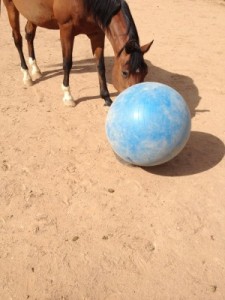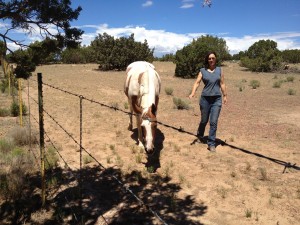“Trick or treat – smell my feet – give me something good to eat” – my little five-year-old grandson goes around saying this and thinks he’s very funny. I think it’s rude, and I told him if he’s polite he may get far more treats!
At Halloween the topic of treats comes up of course, but it comes up often with horse work. I don’t want horses sniffing my pockets all the time, getting pushy, over treats. It makes them demanding and disrespectful.

I work with and without treats. Treats can be useful in liberty training because the things that are most important to a horse are food and territory. If you have some hay, you must eventually move the horse off the hay to establish your role in the herd, so to speak. A horse is used to being told by its mother, its first lesson, that there is a time to eat and a time not to. We want to have that parental role with our horses. So in liberty work there are several ways we can approach this: through working with the hay piles, sometimes carrots or oats. Via the exercise, the horse will eventually not get so focused on the treat but on the activity he shares with you. It is easier to show this than to talk about it, because you begin to feel the difference, the horse becomes respectful and waits at a comfortable distance for you to offer the treat, and he gets his head patted at the same time and lots of praise. From there we can move to companion walking, or dancing or whatever else we want to do with our horses when they are ready to offer it. We don’t always have to offer treats because the horse has learned that sometimes they are part of the lesson and sometimes not. Sometimes the horse will offer wonderful closeness without expecting anything.

Some horses take longer to learn this than others. Some can get aggressive around food, so it may be necessary to use something other than food as a reward. Even if I have a rough time with a horse that doesn’t want to “get” this respect thing, I find that the next time I see him, he is much more respectful. Some horses who do one ritual well will have a hard time with another ritual involving food. In some areas they are in kindergarten and in others they are in high school. I am grateful for what the horse can give me, as long as he recognizes me as someone he wants to be with and not someone he wants to push around, or eat.

Watch the way kids are this Halloween- they expect candy in their bags because they have been trained that on this one night, they go from house to house and people put candy in their bags. However, if they tromp up to a house with their face upturned in a demanding way, the person dispensing candy would maybe feel like they want to take a step backward, they would think, that’s a very bratty kid! They might stick a piece of candy in the bag and close the door quickly, because it isn’t the job of the giver in this case to train the child to take candy in a polite way. Most kids are trained to say “trick or treat!” hold out their bags at a respectful distance, and show some pleasure at what was given, and say “thank you!”
That’s what I want my horses to do – energetically in the way that horses would do that. It also keeps my horses from getting treated unkindly when I’m not around by people who don’t have patience for bad behavior.
The Carolyn Resnick Method of liberty training will put manners on your horse. If he learns correctly, you can take him from his corral without him grabbing for grass while you’re latching the gate. He will lift his head when you ask while he’s grazing, and go back to the grass when you ask (that’s if we have any grass around here!). It takes some time, and creativity, to get this to occur. Companion walking is not just deliriously walking with your horse wanting to be by your side, which is a nice feeling, it is a way to teach him to stop and go, turn and back up at liberty with you so that he is willing and happy to do these things when you are in the saddle.
A friend recently said she didn’t understand the difference between just giving treats and giving them the way I give them. The difference is, I expect the horse to keep a respectful distance, to wait until the treat is offered. I want the horse to learn something from the experience and not have his focus solely on the treat. Then he can savor it. If it is not given and received in the right spirit, then he learns nothing. If he follows me around with his nose too close, I know he thinks of me as something to eat. I’m not comfortable with that. So I don’t carry treats on me when I’m working a horse. The treats are in the bucket or pan, and they can be inside or outside the workspace, depending on what I’m doing.
If a horse gets just too pushy about treats, I stop them for awhile and do something else. We may just hang out together until peace is restored and I don’t have to keep sending him away.
When we see these beautiful equine spectaculars such as those Cavalia produce, know that time, dedication, effort and beautiful energy is behind every performance. This is where they begin, using herd language and dynamics to communicate with their horses. They do not carry treats in a little pouch. They know their horses inside and out, they know how a herd interacts, they know their horses’ beautiful personalities and what activities they enjoy and they build a performance around who they have on stage. These wonderful people live with their horses, day in and day out. Their horses consider them herd members. What a wonderful honor!
I want that honor and I want them to honor me. I don’t have to do equine spectaculars to have it, either. Horses are a club I want to be a member of, so paying attention to what is important to them, food and territory, is something I like to spend a lot of time doing.
If you would like coaching for your horse with these and other lessons, check out my upcoming clinic on November 3rd in Mountainair, NM inspired by the Carolyn Resnick Method of horsemanship. Hope to see you there!




